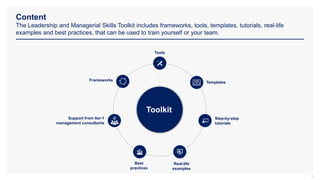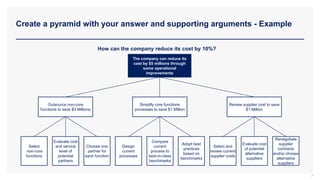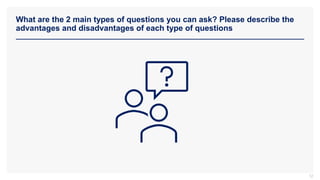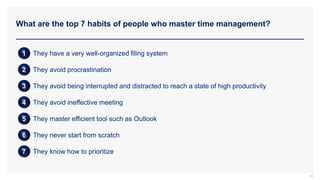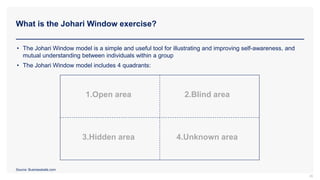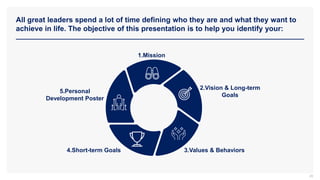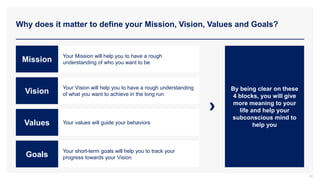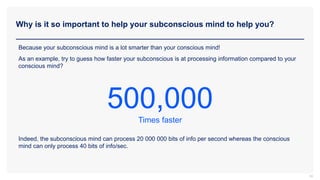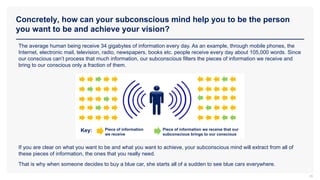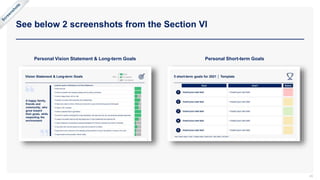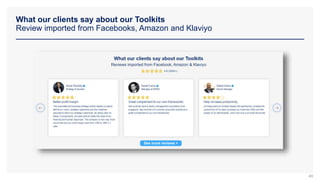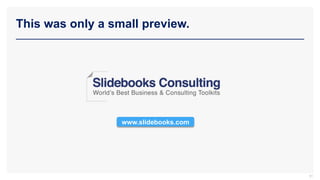Leadership and Managerial Skills Toolkit - Framework, Best Practices and Templates
- 1. Leadership and Managerial Skills Toolkit Overview and Approach Created by ex-McKinsey, Deloitte & BCG Management Consultants
- 2. This Slideshare Powerpoint presentation is only a small preview of our Toolkit. You can download the entire Toolkit in Powerpoint and Excel at www.slidebooks.com 2 www.slidebooks.com
- 3. Content The Leadership and Managerial Skills Toolkit includes frameworks, tools, templates, tutorials, real-life examples and best practices, that can be used to train yourself or your team. 3 Tools Templates Step-by-step tutorials Real-life examples Best practices Support from tier-1 management consultants Frameworks Toolkit
- 4. Objectives The Leadership and Managerial Skills Toolkit was created by ex-McKinsey, Deloitte & BCG Management Consultants specialized in coaching leaders and managers. It will help you: 4 I. Resolve complex problems, structure your reasoning into a coherent and transparent argument, and think creatively. II. Communicate effectively: (1) Don’t use verbal “Communication killers”, (2) Use verbal “Communication openers”, (3) Use non-verbal communication efficiently, (4) Do your homework prior to a real conversation, (5) Encourage someone to continue to talk and tell her story, (6) Check that you’ve understood another person’s position, (7) Use open questions and closed questions smartly, (8) Communicate differently depending on the person’s style. III. Negotiate effectively: (1) Use a “win-win” mindset, (2) Share “win-win” mindset with the other party, (3) Go back to the needs, (4) Be hard on the problem, (5) Emphasize common ground, (6) Be prepared, (7) Double check your understanding, (8) Respond not react, (9) Analyse strengths and weaknesses, (10) Sharpen your saw. IV. Manage your time: (1) Have a very well-organized filing system, (2) Avoid procrastination, (3) Avoid being interrupted and distracted to reach a state of high productivity, (4) Avoid ineffective meeting, (5) Master efficient tool such as Outlook, (6) Never start from scratch, (7) Know how to prioritize. V. Manage your team: (1) Build trust among your team, (2) Define your team’s mission, vision and values, (3) Define your team’s key goals, (4) Define the key roles and responsibilities, (5) Define the ways of working, (6) Create a one-page team charter with your team, (7) Know how to coach your team members, (6) Role model a “constructive” culture, (7) Manage change VI. Define who you want to be, and what you want to achieve: (1) Define your personal mission statement and vision statement, (2) Define your long-term and short-term goals, (3) Define your behaviors and values, (4) Build your personal development poster.
- 5. In the next slides, you’ll see a small preview of the section I 5 I. Resolve complex problems, structure your reasoning into a coherent and transparent argument, and think creatively. II. Communicate effectively: (1) Don’t use verbal “Communication killers”, (2) Use verbal “Communication openers”, (3) Use non-verbal communication efficiently, (4) Do your homework prior to a real conversation, (5) Encourage someone to continue to talk and tell her story, (6) Check that you’ve understood another person’s position, (7) Use open questions and closed questions smartly, (8) Communicate differently depending on the person’s style. III. Negotiate effectively: (1) Use a “win-win” mindset, (2) Share “win-win” mindset with the other party, (3) Go back to the needs, (4) Be hard on the problem, (5) Emphasize common ground, (6) Be prepared, (7) Double check your understanding, (8) Respond not react, (9) Analyse strengths and weaknesses, (10) Sharpen your saw. IV. Manage your time: (1) Have a very well-organized filing system, (2) Avoid procrastination, (3) Avoid being interrupted and distracted to reach a state of high productivity, (4) Avoid ineffective meeting, (5) Master efficient tool such as Outlook, (6) Never start from scratch, (7) Know how to prioritize. V. Manage your team: (1) Build trust among your team, (2) Define your team’s mission, vision and values, (3) Define your team’s key goals, (4) Define the key roles and responsibilities, (5) Define the ways of working, (6) Create a one-page team charter with your team, (7) Know how to coach your team members, (6) Role model a “constructive” culture, (7) Manage change VI. Define who you want to be, and what you want to achieve: (1) Define your personal mission statement and vision statement, (2) Define your long-term and short-term goals, (3) Define your behaviors and values, (4) Build your personal development poster.
- 6. Create a pyramid with your answer and supporting arguments - Template 6 Insert your answer Insert your supporting argument #1.1 Insert your supporting argument #1.2 Insert your supporting argument #1.3 Insert your supporting argument #2.1 Insert your supporting argument #2.2 Insert your supporting argument #2.3 Insert your supporting argument #3.1 Insert your supporting argument #3.2 Insert your supporting argument #1 Insert your supporting argument #2 Insert your supporting argument #3 Insert your supporting argument #3,3 Insert your introduction’s question Why or How? Why or How? Why or How? Why or How? To communicate in a structured way with a busy executive, you should start with the answer to the executive’s question first, and then list your supporting arguments Group, summarize and order logically your supporting arguments
- 7. Create a pyramid with your answer and supporting arguments - Example 7 The company can reduce its cost by $5 millions through some operational improvements Select non-core functions Evaluate cost and service level of potential partners Choose one partner for each function Design current processes Compare current process to best-in-class benchmarks Adopt best practices based on benchmarks Select and review current supplier costs Evaluate cost of potential alternative suppliers Outsource non-core functions to save $3 Millions Simplify core functions processes to save $1 Million Review supplier cost to save $1 Million Renegotiate supplier contracts and/or choose alternative suppliers How can the company reduce its cost by 10%?
- 8. In the next slides, you’ll see a small preview of the section II 8 I. Resolve complex problems, structure your reasoning into a coherent and transparent argument, and think creatively. II. Communicate effectively: (1) Don’t use verbal “Communication killers”, (2) Use verbal “Communication openers”, (3) Use non-verbal communication efficiently, (4) Do your homework prior to a real conversation, (5) Encourage someone to continue to talk and tell her story, (6) Check that you’ve understood another person’s position, (7) Use open questions and closed questions smartly, (8) Communicate differently depending on the person’s style. III. Negotiate effectively: (1) Use a “win-win” mindset, (2) Share “win-win” mindset with the other party, (3) Go back to the needs, (4) Be hard on the problem, (5) Emphasize common ground, (6) Be prepared, (7) Double check your understanding, (8) Respond not react, (9) Analyse strengths and weaknesses, (10) Sharpen your saw. IV. Manage your time: (1) Have a very well-organized filing system, (2) Avoid procrastination, (3) Avoid being interrupted and distracted to reach a state of high productivity, (4) Avoid ineffective meeting, (5) Master efficient tool such as Outlook, (6) Never start from scratch, (7) Know how to prioritize. V. Manage your team: (1) Build trust among your team, (2) Define your team’s mission, vision and values, (3) Define your team’s key goals, (4) Define the key roles and responsibilities, (5) Define the ways of working, (6) Create a one-page team charter with your team, (7) Know how to coach your team members, (6) Role model a “constructive” culture, (7) Manage change VI. Define who you want to be, and what you want to achieve: (1) Define your personal mission statement and vision statement, (2) Define your long-term and short-term goals, (3) Define your behaviors and values, (4) Build your personal development poster.
- 9. Can you take 5 minutes to list the main verbal “Communication killers” you hear on a weekly basis? 9 Ordering "You must work together..." Threatening "You better..." Moralizing "It is your responsibility..." Advice-Giving "If I were you..." Judging You are still too new...inexperienced..." Interrogating "Why did you...?" Ridiculing “Can you stop crying like a baby…” Interpreting "Your problem is..." Verbal Communication Killers Hidden Meaning
- 10. If you had a real conversation with one of your subordinates, what kind of non-verbal communications would you use to encourage her to openly discuss & express her feelings? 10 S Sit facing the other person squarely O Adopt an open posture when you are talking L Lean towards the other person V Make sure your voice qualities like tone, pitch and loudness are appropriate to the conversation E Use good eye contact R Try to be Relax. It will help the other person to also relax and will show that you are comfortable listening to her
- 11. How do you check that you’ve understood another person’s position? 11 By using reflecting and paraphrasing techniques. Reflecting and paraphrasing techniques will help you to: • Demonstrate that you are listening • Make the other person know that they have been heard (e.g. “I hear you say that the management…) • Clarify what the person has said (e.g. “So if my understanding is correct you…is that right?”) It is also important to observe and if relevant acknowledge the other person’s emotions
- 12. What are the 2 main types of questions you can ask? Please describe the advantages and disadvantages of each type of questions 12
- 13. What are the 2 main types of questions you can ask? Please describe the advantages and disadvantages of each type of questions 13 The closed questions and the open questions: The closed questions The open questions Closed questions start by “Is”, “Are”, “Do”, “Does”,…: • Do you like your new role? • Is it your first experience as a manager? They can be answered by a single word such as “Yes” or “No” Open questions starts by “Why”, “When”, “How”, “What”…: • How do you feel about this whole situation? • What can I do for you? They promote open-mindedness and invite many answers or possibilities These questions are good for obtaining specific information and clarifying issues. These questions do not encourage a person to talk openly and do not provide you with adequate material to work Advantage Disadvantage These questions stimulate the exploration of concepts and ideas and facilitate creative and critical thinking You may receive unnecessary information Not appropriate if you have a tight timeframe Advantage Disadvantage
- 14. It is also very important to learn how to communicate differently depending on the person’s style 14 According to MBTI, people can be categorized as: Extrovert Introvert Sensing Intuition Thinking Feeling Judging Perceiving
- 15. In the next slides, you’ll see a small preview of the section III 15 I. Resolve complex problems, structure your reasoning into a coherent and transparent argument, and think creatively. II. Communicate effectively: (1) Don’t use verbal “Communication killers”, (2) Use verbal “Communication openers”, (3) Use non-verbal communication efficiently, (4) Do your homework prior to a real conversation, (5) Encourage someone to continue to talk and tell her story, (6) Check that you’ve understood another person’s position, (7) Use open questions and closed questions smartly, (8) Communicate differently depending on the person’s style. III. Negotiate effectively: (1) Use a “win-win” mindset, (2) Share “win-win” mindset with the other party, (3) Go back to the needs, (4) Be hard on the problem, (5) Emphasize common ground, (6) Be prepared, (7) Double check your understanding, (8) Respond not react, (9) Analyse strengths and weaknesses, (10) Sharpen your saw. IV. Manage your time: (1) Have a very well-organized filing system, (2) Avoid procrastination, (3) Avoid being interrupted and distracted to reach a state of high productivity, (4) Avoid ineffective meeting, (5) Master efficient tool such as Outlook, (6) Never start from scratch, (7) Know how to prioritize. V. Manage your team: (1) Build trust among your team, (2) Define your team’s mission, vision and values, (3) Define your team’s key goals, (4) Define the key roles and responsibilities, (5) Define the ways of working, (6) Create a one-page team charter with your team, (7) Know how to coach your team members, (6) Role model a “constructive” culture, (7) Manage change VI. Define who you want to be, and what you want to achieve: (1) Define your personal mission statement and vision statement, (2) Define your long-term and short-term goals, (3) Define your behaviors and values, (4) Build your personal development poster.
- 16. What are the main skills of a great negotiator? 16 Communication skills, both verbal and non-verbal Ability to 'read' the other parties' speech and body language Ability to avoid becoming impatient, excited and emotive Ability to be self confident without being perceived as arrogant
- 17. In the next slides, you’ll see a small preview of the section IV 17 I. Resolve complex problems, structure your reasoning into a coherent and transparent argument, and think creatively. II. Communicate effectively: (1) Don’t use verbal “Communication killers”, (2) Use verbal “Communication openers”, (3) Use non-verbal communication efficiently, (4) Do your homework prior to a real conversation, (5) Encourage someone to continue to talk and tell her story, (6) Check that you’ve understood another person’s position, (7) Use open questions and closed questions smartly, (8) Communicate differently depending on the person’s style. III. Negotiate effectively: (1) Use a “win-win” mindset, (2) Share “win-win” mindset with the other party, (3) Go back to the needs, (4) Be hard on the problem, (5) Emphasize common ground, (6) Be prepared, (7) Double check your understanding, (8) Respond not react, (9) Analyse strengths and weaknesses, (10) Sharpen your saw. IV. Manage your time: (1) Have a very well-organized filing system, (2) Avoid procrastination, (3) Avoid being interrupted and distracted to reach a state of high productivity, (4) Avoid ineffective meeting, (5) Master efficient tool such as Outlook, (6) Never start from scratch, (7) Know how to prioritize. V. Manage your team: (1) Build trust among your team, (2) Define your team’s mission, vision and values, (3) Define your team’s key goals, (4) Define the key roles and responsibilities, (5) Define the ways of working, (6) Create a one-page team charter with your team, (7) Know how to coach your team members, (6) Role model a “constructive” culture, (7) Manage change VI. Define who you want to be, and what you want to achieve: (1) Define your personal mission statement and vision statement, (2) Define your long-term and short-term goals, (3) Define your behaviors and values, (4) Build your personal development poster.
- 18. What are the top 7 habits of people who master time management? 18 1 They have a very well-organized filing system 2 They avoid procrastination 3 They avoid being interrupted and distracted to reach a state of high productivity 4 They avoid ineffective meeting 5 They master efficient tool such as Outlook 6 They never start from scratch 7 They know how to prioritize
- 19. On average, how many weeks per year do white collars workers spend looking for information they already have? 19
- 20. On average, how many weeks per year do white collars workers spend looking for information they already have? 20 6 weeks! Having an organised filing system will help you to save about 3 weeks per years searching information that you already have
- 21. There are 3 simple steps to fix you cluttered desk and increase your focus 21 Step 1 - Think Step 2 - Sweat Step 3 - Organize 1 2 3
- 22. There are 3 simple steps to fix you cluttered desk and increase your focus 22 Step 1 - Think Step 2 - Sweat Step 3 - Organize 1 2 3 Thinking about a the most efficient filing system for you, a filing system that relates to how you think, how you view your role Tips/Activities Be logical and simple Create a filing system so logical and simple that you will be happy to use even in period of high stress Identify your different hats Identify your key folders and subfolders based on your different hats. For example a sales manager could use the following folders and subfolders: Folder Subfolders Team Management John X, Sasha Y,... Key account management NSW, WA, VIC,... Marketing Advertising, Website,... Strategy Corporate Strategy, Divisional Strategy, Sales strategy,... Source: Work smarter: Live better – Cyril Peupion
- 23. In the next slides, you’ll see a small preview of the section V 23 I. Resolve complex problems, structure your reasoning into a coherent and transparent argument, and think creatively. II. Communicate effectively: (1) Don’t use verbal “Communication killers”, (2) Use verbal “Communication openers”, (3) Use non-verbal communication efficiently, (4) Do your homework prior to a real conversation, (5) Encourage someone to continue to talk and tell her story, (6) Check that you’ve understood another person’s position, (7) Use open questions and closed questions smartly, (8) Communicate differently depending on the person’s style. III. Negotiate effectively: (1) Use a “win-win” mindset, (2) Share “win-win” mindset with the other party, (3) Go back to the needs, (4) Be hard on the problem, (5) Emphasize common ground, (6) Be prepared, (7) Double check your understanding, (8) Respond not react, (9) Analyse strengths and weaknesses, (10) Sharpen your saw. IV. Manage your time: (1) Have a very well-organized filing system, (2) Avoid procrastination, (3) Avoid being interrupted and distracted to reach a state of high productivity, (4) Avoid ineffective meeting, (5) Master efficient tool such as Outlook, (6) Never start from scratch, (7) Know how to prioritize. V. Manage your team: (1) Build trust among your team, (2) Define your team’s mission, vision and values, (3) Define your team’s key goals, (4) Define the key roles and responsibilities, (5) Define the ways of working, (6) Create a one-page team charter with your team, (7) Know how to coach your team members, (6) Role model a “constructive” culture, (7) Manage change VI. Define who you want to be, and what you want to achieve: (1) Define your personal mission statement and vision statement, (2) Define your long-term and short-term goals, (3) Define your behaviors and values, (4) Build your personal development poster.
- 24. What are the top 7 habits of great team managers? 24 1 They build trust among their team 2 They define the team’s mission, vision and values 3 They define the team’s key goals 4 They define key roles and responsibilities 5 They define ways of working 6 They create a one-page team charter with their team 7 They know how to coach their team members
- 25. How does a great team manager build trust among his team? 25 • A great team manager usually organizes and facilitates a 2-hour workshop in order to build trust among his team • During the workshop, the team manager will try to increase how well each member of the team knows him and each other, both on a professional and personal level • The workshop agenda usually includes the following sessions: − A 5 min Ice breaker − Everyone will briefly introduce themselves − The team manager will then spend 5 minutes to interactively explain the importance of building trust within the team − The team manager will organize an exercise to ensure everyone knows each other well, both on a professional and personal level. An example of well known exercise is called the Johari Window
- 26. What is the Johari Window exercise? 26 • The Johari Window model is a simple and useful tool for illustrating and improving self-awareness, and mutual understanding between individuals within a group • The Johari Window model includes 4 quadrants: 3.Hidden area 4.Unknown area 1.Open area 2.Blind area Source: Businessballs.com
- 27. What is the Johari Window exercise? 27 • The Johari Window model is a simple and useful tool for illustrating and improving self-awareness, and mutual understanding between individuals within a group • The Johari Window model includes 4 quadrants: 3.Hidden area 4.Unknown area 1.Open area 2.Blind area What is known by the person about him/herself and is also known by others (behavior, feelings, knowledge, experience, skills, views, etc.)? What is unknown by the person about him/herself but which others know? What the person knows about him/herself that others do not know ? What is unknown by the person about him/herself and is also unknown by others
- 28. In the next slides, you’ll see a small preview of the section VI 28 I. Resolve complex problems, structure your reasoning into a coherent and transparent argument, and think creatively. II. Communicate effectively: (1) Don’t use verbal “Communication killers”, (2) Use verbal “Communication openers”, (3) Use non-verbal communication efficiently, (4) Do your homework prior to a real conversation, (5) Encourage someone to continue to talk and tell her story, (6) Check that you’ve understood another person’s position, (7) Use open questions and closed questions smartly, (8) Communicate differently depending on the person’s style. III. Negotiate effectively: (1) Use a “win-win” mindset, (2) Share “win-win” mindset with the other party, (3) Go back to the needs, (4) Be hard on the problem, (5) Emphasize common ground, (6) Be prepared, (7) Double check your understanding, (8) Respond not react, (9) Analyse strengths and weaknesses, (10) Sharpen your saw. IV. Manage your time: (1) Have a very well-organized filing system, (2) Avoid procrastination, (3) Avoid being interrupted and distracted to reach a state of high productivity, (4) Avoid ineffective meeting, (5) Master efficient tool such as Outlook, (6) Never start from scratch, (7) Know how to prioritize. V. Manage your team: (1) Build trust among your team, (2) Define your team’s mission, vision and values, (3) Define your team’s key goals, (4) Define the key roles and responsibilities, (5) Define the ways of working, (6) Create a one-page team charter with your team, (7) Know how to coach your team members, (6) Role model a “constructive” culture, (7) Manage change VI. Define who you want to be, and what you want to achieve: (1) Define your personal mission statement and vision statement, (2) Define your long-term and short-term goals, (3) Define your behaviors and values, (4) Build your personal development poster.
- 29. All great leaders spend a lot of time defining who they are and what they want to achieve in life. The objective of this presentation is to help you identify your: 29 2.Vision & Long-term Goals 3.Values & Behaviors 4.Short-term Goals 5.Personal Development Poster 1.Mission
- 30. 30 Before jumping into the heart of the training, let’s start by some background questions
- 31. Why does it matter to define your Mission, Vision, Values and Goals? 31 You have 5 minutes to answer this question. Don’t hesitate to use post-it that you can stick on a wall. Keep it mind, 1 key message per post-it
- 32. Why does it matter to define your Mission, Vision, Values and Goals? 32 Your Mission will help you to have a rough understanding of who you want to be Mission Vision Your values will guide your behaviors Values Your short-term goals will help you to track your progress towards your Vision Goals Your Vision will help you to have a rough understanding of what you want to achieve in the long run By being clear on these 4 blocks, you will give more meaning to your life and help your subconscious mind to help you
- 33. Why is it so important to help your subconscious mind to help you? 33 Because your subconscious mind is a lot smarter than your conscious mind! As an example, try to guess how faster your subconscious is at processing information compared to your conscious mind?
- 34. Why is it so important to help your subconscious mind to help you? 34 Because your subconscious mind is a lot smarter than your conscious mind! As an example, try to guess how faster your subconscious is at processing information compared to your conscious mind? Indeed, the subconscious mind can process 20 000 000 bits of info per second whereas the conscious mind can only process 40 bits of info/sec. 500,000 Times faster
- 35. Concretely, how can your subconscious mind help you to be the person you want to be and achieve your vision? 35 The average human being receive 34 gigabytes of information every day. As an example, through mobile phones, the Internet, electronic mail, television, radio, newspapers, books etc. people receive every day about 105,000 words. Since our conscious can’t process that much information, our subconscious filters the pieces of information we receive and bring to our conscious only a fraction of them. If you are clear on what you want to be and what you want to achieve, your subconscious mind will extract from all of these pieces of information, the ones that you really need. That is why when someone decides to buy a blue car, she starts all of a sudden to see blue cars everywhere. Key: Piece of information we receive Piece of information we receive that our subconscious brings to our conscious
- 36. The objective of this training is to help you identify your: 36 2.Vision & Long-term Goals 3.Values & Behaviors 4.Short-term Goals 5.Personal Development Poster 1.Mission
- 37. Agenda 37 2.Vision & Long-term Goals 3.Values & Behaviors 4.Short-term Goals 5.Personal Development Poster 1.Mission
- 38. How do you define your Mission? 38
- 39. How do you define your Mission? 39 To define your Mission, try to answer questions such as: What is the reason of your existence? What is the purpose of your life? Or Yes I know, it doesn’t seem that easy, but if it was, it wouldn’t be fun Defining a Mission is an iterative process. Create a first draft and then update it each time a new idea or a new way to phrase it comes into your mind
- 40. How long does your Mission statement should be? 40 There is no specific rule. It can be 1 or 2 sentences but some people prefer to use 1 whole page. There is no 1 solution fits all. However, having a short and simple Mission statement is often more powerful, as it will be a lot easier for your subconscious to understand it. Usually it is a lot more difficult to write down 1 or 2 sentences than a whole page. As Mark Twain said: “I didn’t have time to write a short letter, so I wrote a long one instead”. For that reason I would recommend to write down 1 page for your first mission statement draft. Then, for your second draft, you could synthesize it, making sure that all the words you use matter.
- 41. 41 In the next slide, you’ll see examples of Mission Statement. In order not to be influenced, I wouldn’t read them before creating your own first draft. Keep also in mind that there is no right way or wrong way to do it. There is only YOUR way
- 42. Example of Personal Mission Statement 42 Denise Morrison CEO of Campbell Soup Company To serve as a leader, live a balanced life, and apply ethical principles to make a significant difference.
- 43. Example of Mission Statement 43 Joel Manby CEO of Herschend Family Entertainment I define personal success as being consistent to my own personal mission statement: to love God and love others.
- 44. Example of Mission Statement 44 Oprah Winfrey Founder of Own, The Oprah Winfrey Network To be a teacher. And to be known for inspiring my students to be more than they thought they could be.
- 45. See below 2 screenshots from the Section VI 45 Personal Vision Statement & Long-term Goals Personal Short-term Goals
- 46. Structure of the Toolkit The Leadership and Managerial Skills Toolkit includes 240 Powerpoint slides categorized in 7 documents that you can download on your device immediately after your purchase. 46 1 0. Overview and approach 240 editable Powerpoint slides* *Please note that the number of Powerpoint slides listed is the number of unique slides. For example, a Powerpoint slide that has been duplicated to facilitate the understanding of our clients only count for 1 Powerpoint slide. 2 I. Resolve complex problems and structure your reasoning 3 II. Communicate effectively 4 III. Negotiate effectively 5 IV. Manage your time 7 VI. Define who you want to be and what you want to achieve 6 V. Manage your team
- 47. Interested in more than 1 Toolkit? You can access to all our Toolkits for half the price with the Gold Business & Consulting Package www.slidebooks.com Gold Business & Consulting Package Learn More 47
- 48. Key Benefits of our Business & Consulting Toolkits 48 Improve the growth & efficiency of your organization by leveraging Business & Consulting Toolkits created by ex-McKinsey, Deloitte & BCG Consultants. It cost us $1.7M to create all our Business & Consulting Toolkits. Get them for a fraction of this cost. It’s like hiring Management Consultants to create all the practical Frameworks, Tools & Templates required to get a competitive advantage. Get the job done quicker and never start from scratch again with our ready-made & fully editable Frameworks, Tools & Templates in Powerpoint & Excel. We have worked 20,000+ hours over the past 5 years to create the world’s best Business & Consulting Toolkits. Don’t reinvent the wheel. Download now. Improve your skills & capabilities and meet your professional goals by learning how the Fortune 100 and Global Consulting Firms do it. Get free support and advice from our ex-McKinsey, Deloitte & BCG Management Consultants. Hiring top-tier Consultants for a management consulting project would cost you $300k+. A lot more expensive than purchasing our Toolkits. Impress your stakeholders and become your organization’s subject matter expert with world-class approaches to resolve common business problems.
- 49. What our clients say about our Toolkits Review imported from Facebooks, Amazon and Klaviyo 49 See more reviews >
- 50. 50 Trusted by small and large organizations Customer satisfaction Number of countries leveraging our Business & Consulting Toolkits 160+ Number of professionals leveraging our Business & Consulting Toolkits 200,000+ 4.8 Daily rate of our ex-McKinsey, Deloitte and BCG Management Consultants $3k - $4k Join the 200,000+ Executives, Consultants & Entrepreneurs leveraging our Business & Consulting Toolkits to improve the performance of their organization and boost their own career.
- 51. This was only a small preview. www.slidebooks.com 51



